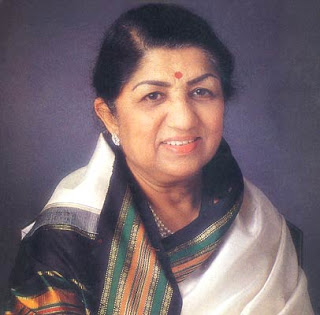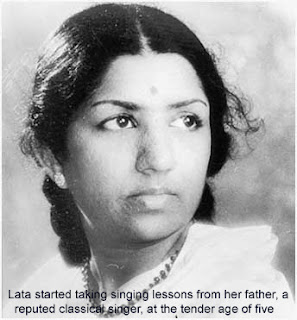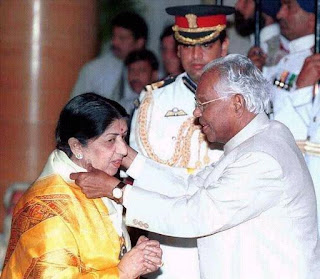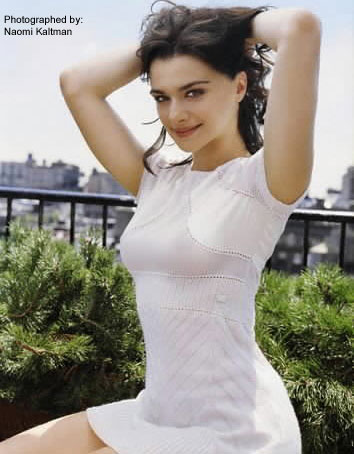Lata Mangeshkar – the uncrowned queen of Indian playback singing.

Lata Mangeshkar had dominated Indian playback singing for such a long period of time that she can be considered uncrowned queen of Indian playback singing. She made her presence felt right from the time of Mahal, picturised on Madhubala, with hits songs like “ayega anewala”, in 1947, till Dil to Pagal Hai, picturised on Madhuri Dixit. Not only was she sublime in her performance, she had been the role model of numerous female singers of the present generation.
She was blessed with a romantic voice which had classical training and outstanding range which could suit any situation in a film. Her association with all the composers (excepting OP Nayyar), creates a separate identity along with Rafi. Her everlasting performances include “duniya kare sawal” picturised on Meena Kumari, composed by Roshan, “aja re pardesi” picturised on Vaijayantimala, composed by Salil Chowdhury, “aaj phir jeene ki tamanna hai”, picturised on Wahida Rehman, composed by Sd Burman, “aji ruth kar ab” composed by Shankar Jaikishan for Sadhna, “alla tero naam” composed by Jaidev for Nanda, “aya sawan jhumke” composed by Laxmikant Pyarellal for Asha Parekh, “dil dhoonta hai” composed by Madanmohan for Sharmila Tagore, “o jab tak hai jaan” for Hema Malini, “is more se jate hai” for Suchitra Sen, composed by RD Burman. The list can go on. Even composers like Naushad, Ravi, Kalyanji Anandji, Khayyam loved her the most.

Even actresses like Madhuri Dixit, Kareena Kapoor, Sri Devi, Rani Mukherjee, Preety Zinta had given lips in her songs. She had sung for all the big banners of Bollywood, including Raj Kapoor’s Banner, Dev Anand’s Navketan Banner, Dilip Kumar production, GP Sippy Banner, etc. She had sung between 25,000 to 30,000 songs in a span of 60 years. So her contribution cannot be highlighted in a small article.

Neither do the awards given to her including filmfare awards, national awards project her domination in the industry. Other than Rafi, no other playback singer had dominated the Indian silver screen like Lata. She also had sung huge number of duet songs with Rafi, Kishore, Mukesh, Manna Dey, etc. Singers of the new generation should follow her footsteps for sustaining the challenges in playback singing according to the need of the present time.
She was blessed with a romantic voice which had classical training and outstanding range which could suit any situation in a film. Her association with all the composers (excepting OP Nayyar), creates a separate identity along with Rafi. Her everlasting performances include “duniya kare sawal” picturised on Meena Kumari, composed by Roshan, “aja re pardesi” picturised on Vaijayantimala, composed by Salil Chowdhury, “aaj phir jeene ki tamanna hai”, picturised on Wahida Rehman, composed by Sd Burman, “aji ruth kar ab” composed by Shankar Jaikishan for Sadhna, “alla tero naam” composed by Jaidev for Nanda, “aya sawan jhumke” composed by Laxmikant Pyarellal for Asha Parekh, “dil dhoonta hai” composed by Madanmohan for Sharmila Tagore, “o jab tak hai jaan” for Hema Malini, “is more se jate hai” for Suchitra Sen, composed by RD Burman. The list can go on. Even composers like Naushad, Ravi, Kalyanji Anandji, Khayyam loved her the most.

Even actresses like Madhuri Dixit, Kareena Kapoor, Sri Devi, Rani Mukherjee, Preety Zinta had given lips in her songs. She had sung for all the big banners of Bollywood, including Raj Kapoor’s Banner, Dev Anand’s Navketan Banner, Dilip Kumar production, GP Sippy Banner, etc. She had sung between 25,000 to 30,000 songs in a span of 60 years. So her contribution cannot be highlighted in a small article.

Neither do the awards given to her including filmfare awards, national awards project her domination in the industry. Other than Rafi, no other playback singer had dominated the Indian silver screen like Lata. She also had sung huge number of duet songs with Rafi, Kishore, Mukesh, Manna Dey, etc. Singers of the new generation should follow her footsteps for sustaining the challenges in playback singing according to the need of the present time.

